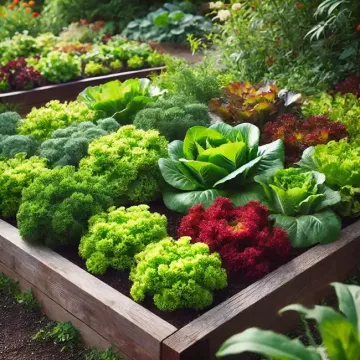Lettuce is a versatile and rewarding crop to grow in the home garden. Whether you're looking to cultivate crisp heads or tender baby leaves, lettuce can fit into any garden plan with ease. Its relatively fast growth, combined with the ability to be grown in both cool and warm seasons, makes lettuce a staple in many home gardens. This article covers different varieties suited for various seasons, tips for planting and care, and harvesting techniques, including the popular cut-and-come-again method.
Varieties for Cool Season vs. Warm Season
Cool Season Varieties Lettuce thrives in cooler temperatures, typically between 60°F and 70°F. During the spring and fall, focus on growing varieties that are best suited to these conditions. Here are some popular cool-season varieties:
- Butterhead (Boston, Bibb) – These varieties form loose heads with tender, buttery leaves. They grow well in cool weather and have a sweet, mild flavor.
- Romaine (Cos) – Known for their tall heads and crisp leaves, romaine varieties like 'Parris Island Cos' are highly tolerant of cool temperatures.
- Looseleaf – Varieties like 'Black-Seeded Simpson' and 'Salad Bowl' are highly adaptable and perform well in cooler weather, producing tender, leafy greens.
- Iceberg – Though more challenging to grow, iceberg lettuce like 'Great Lakes' thrives in cooler weather, forming crisp, dense heads.
Warm Season Varieties While lettuce prefers cooler weather, some varieties are more tolerant of heat, allowing for successful growth in late spring and early summer. These heat-tolerant varieties are slower to bolt and can handle higher temperatures:
- Batavian (Summer Crisp) – Varieties like 'Nevada' and 'Muir' are among the most heat-tolerant. They have a crunchy texture and a sweet flavor that holds up well in warmer temperatures.
- Butterhead – Certain butterhead varieties, such as 'Optima' and 'Buttercrunch,' can withstand the heat better than others.
- Looseleaf – Varieties like 'Red Sails' are heat-tolerant and slow to bolt, making them ideal for summer planting.
- Oakleaf – Known for their lobed leaves, oakleaf varieties such as 'Green Oakleaf' are slower to bolt and can handle warmer temperatures.
Planting and Care
Soil Preparation Lettuce prefers well-drained, fertile soil rich in organic matter. Preparing the garden bed with compost or aged manure helps ensure the soil retains moisture while also providing nutrients. A slightly acidic to neutral pH (6.0-7.0) is ideal.
Planting For cool-season lettuce, plant seeds directly in the garden as soon as the soil can be worked in early spring. Lettuce seeds are small, so they should be sown shallowly—no more than 1/4 inch deep. Thin seedlings to prevent overcrowding, leaving 6-12 inches of space between plants, depending on the variety.
In warm seasons, plant heat-tolerant varieties either in the early morning or late afternoon to avoid the intense midday heat. Mulching around the plants can help regulate soil temperature and retain moisture.
Watering Lettuce has shallow roots and requires consistent watering to maintain tender, sweet leaves. Keep the soil evenly moist but not waterlogged. Drip irrigation or soaker hoses are ideal for ensuring the plants receive consistent moisture without wetting the leaves, which can lead to disease.
Fertilizing A balanced fertilizer applied during planting and throughout the growing season will encourage healthy growth. Avoid excessive nitrogen, as it can lead to overly lush growth susceptible to pests and disease.
Harvesting Methods
Lettuce is highly versatile when it comes to harvesting. You can harvest entire heads, individual leaves, or use the popular "cut and come again" method, depending on the variety and your gardening needs.
Harvesting Full Heads To harvest full heads, wait until the lettuce reaches maturity, usually around 55-70 days after planting, depending on the variety. Use a sharp knife to cut the plant at the base, just above the soil line. For varieties like romaine, iceberg, and butterhead, this method ensures you get the full experience of the mature plant.
Cut and Come Again The cut-and-come-again method is ideal for looseleaf varieties and is perfect for gardeners who want a continuous supply of fresh leaves. Instead of harvesting the entire plant, use scissors or a knife to trim the outer leaves, leaving the center of the plant intact. This allows the plant to continue producing new leaves, often providing multiple harvests throughout the season.
When using this method, harvest leaves when they are about 3-6 inches long. Be sure to leave at least an inch of growth at the base of the plant. This method can extend your lettuce harvest for weeks, especially if you stagger plantings every couple of weeks.
Successive Planting Lettuce can also be planted successively for a continuous harvest. Plant new seeds every 2-3 weeks during the growing season. This ensures you always have fresh lettuce available and avoids having a glut of mature heads all at once.
Conclusion
Growing lettuce in the home garden offers a rewarding and flexible gardening experience. With varieties suited for both cool and warm seasons, lettuce can be grown almost year-round in many regions. By choosing the right varieties for your climate, providing consistent care, and using efficient harvesting methods like cut-and-come-again, you can enjoy a continuous supply of fresh, healthy greens from your garden.

